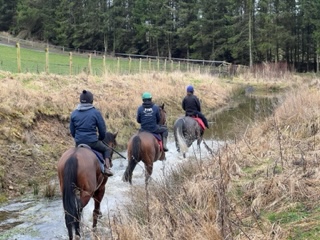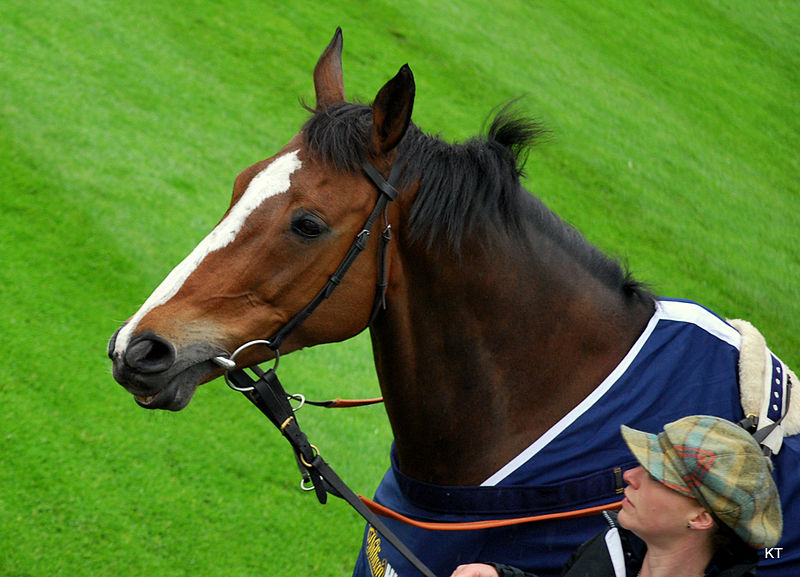The Hot Race Method For Finding Future Winners
This Hot Race Method for finding future winners is massively underrated.
 Hot Race Winner Kauto Star
Hot Race Winner Kauto StarThis article is written by Sam Darby, a professional tipster who operates on the SureWin platform. He’s sought to become the best horse racing tipster over the past decade or so and he’ll be sharing the method he uses to find hundreds of winners each season.
The Race That Opened My Eyes
The more time you spend betting on horse racing, the more you learn. I was very fortunate in that pure luck led to me unearthing a brilliant strategy for finding future winners very early on in my adult life.
At the age of 19/20 I was working part time as a bookie whilst at University. I was interested in betting on horses but at that point I was largely following the general consensus of several tipsters - a strategy that was never really going to favour me in the long term.
Around that time, I was aware of the success that part owner Sir Alex Ferguson had with Rock Of Gibraltar. Shortly after that horse was retired I read that he was also the part owner of a lightly raced 3yo named Gatwick.
 Alex Ferguson
Alex FergusonHe’d only run once as a 2yo and it was a promising effort, so I naively thought this might be the next Rock Of Gibraltar and I wanted to follow him. I backed him on his first start as a 3yo and he duly won a maiden at 4/1 so it was a great start.
Next up it was his handicap debut at Newbury and I backed him again. He could only manage 3rd on this occasion and I was disappointed that he seemingly wasn’t good enough to win a handicap. What I noticed in the coming weeks though would lead to me backing thousands of winners in the next couple of decades through one very simple method.
As I was working at a bookies at the time I was watching a lot of racing. Within the next month or so I noticed that several of the runners who had finished in close proximity to Gatwick on his handicap debut were winning next time out.
By the time Gatwick ran again the winner of that Newbury handicap had won twice since, the runner up had won and the 6th had won too.
Because the race had been working out so well, I recognised that Gatwick probably had an impossible task on handicap debut and I wanted to back him next time out.
I had my biggest ever bet at the time and Gatwick landed a big gamble by scooting up at Goodwood.
 Goodwood Racecourse
Goodwood RacecourseThis theme of runners coming out of that Newbury race and either winning, or running very well, would continue in the coming months. In the end, the form figures of the first nine runners home from the race, on their next two starts combined, in order were:
112111231213343233
If you’d have placed £20 each way on every one of those runners, on their next 2 starts, you’d have won £2,422! And that's at SP, it would have been a lot more getting the juicy early prices.
Those nine horses that produced those form figures, would go on to rate a combined 183 lbs higher at their peak, than they were rated in that handicap - potentially marking that Newbury contest as the best piece of handicap form ever!
On the subject of Gatwick, he’d win another big handicap after Goodwood resulting in connections supplementing him for the 2004 Vodaphone Derby Stakes.
He wasn’t good enough for that, and didn’t stay the trip, but he’d win another handicap later in the season and he’d finish the season rated 108. That’s 25lbs higher than when I backed him when 3rd at Newbury on handicap debut.
Just a One Off, or a Profit Guarantee?
I started to wonder how many more races worked out like this and whether or not I could spot them early on.
Fortunately I’d soon figure out that this method of form research could produce hundreds of winners each season. I don’t think there have been any races as strong as that Newbury race since but there are many races each season that throw up multiple future winners and I’d come to know these races as ‘hot form’.
The most common races that become hot form are big field, 3yo handicaps, like that Newbury race. These are the races where many of the runners are open to plenty of improvement.
On several occasions there will be multiple runners coming together that are miles ahead of their current marks and therefore most likely to continue winning on their next few starts, even if beaten in the ‘hot race’.
It’s worth noting that handicaps for older horses can also become hot form. Usually, the more unexposed runners there are in the race, the more likely it is that there will be improvers and future winners amongst them. Sometimes though, even races full of exposed runners can throw up future winners too.
Overall, you can probably expect to find fifty or so races that will produce several next time out winners and maybe ten of those will be ‘red hot’ races that might throw up seven or eight future winners.
The Hot Race Method For Finding Future Winners
This is valuable information and there are several ways you can go about this.
Some subscription websites have tools that allow this to be a relatively speedy process. Some sites let users search through races to highlight contests that are showing signs of hot form, based on the parameters the user sets. Other sites show runners that have an entry with a recent run that can be considered ‘hot form’.
You can also find these races without the need for any subscription websites, but it does take a bit longer. The more labour intensive version is actually my preferred method as it enables me to ‘monitor’ races as they are working out, and I can keep a very close eye on results as soon as one winner comes out of the race.
Alternative methods can sometimes lead to you finding out about these hot races when it’s already too late.
One big time saver is the ‘Future Form’ tab on any results page on the AtTheRaces website. This shows the subsequent runs of all the race participants in one, easy to consume snapshot.
A look at that for each race, two to four weeks following the event, can give plenty of insight into how strong each race is. Weak races can be discarded, races showing promise can be bookmarked (to be revisited) and if the race is definitely working out, add the runners that ran well to your tracker.
The need to wait 2 to 4 weeks is to allow some subsequent runs, but not so many that you’ve already missed the boat if the race does turn out to be hot form. Two, maybe three runs from those that finished within a few lengths of the winner should be enough to get an idea about the strength of the form.
Backing The Right Runners

Although you wouldn’t go massively wrong by following just the placed horses from each of these hot races, it’s a bit more complicated than that and once you’ve found a hot race, you want to get every possible winner from the race.
As a general rule, in each hot race you want to follow any runner with close proximity to a future winner. The further ahead of a future winner they have finished, the more interesting they are likely to be next time out.
Example of the hot race method for finding future winners:
Let’s say there is a 14 runner handicap and the 3rd, 4th and 6th have already won on their next start. The winner, runner up and 5th are obviously going to be interesting next time. So might the 7th be if he was only half a length or so behind the 6th, but if he was two lengths behind then he’d be of far less interest.
It’s also worth remembering that the bare result isn’t always an accurate reflection of each horse’s ability in any given race. In pretty much every race that is run there are horses that are better than the bare result and others that are flattered by the result.
Using the above example again where the 3rd, 4th and 6th in a race have come out and won, it might actually be the case that, going forward, the 5th is going to be more interesting than the 1st and 2nd. This could potentially be because the trip or ground wasn’t perfect for the 5th or perhaps they were badly drawn or not seen to best effect because of the pace of the race.
Once you’ve identified a hot race, and the runners that are likely to be of most interest, it’s time to add them to your tracker.
It’s always worth including a note about the race they came from, reminding you what the ideal conditions are for the horse and why they should possibly be upgraded or downgraded from their hot form race.
When you are adding 500+ horses to your tracker each season those notes are going to be a massive help and time saver when called upon.
 Royal Ascot Races
Royal Ascot RacesAre They All Going To Win?
Unfortunately not. Some of these runners will be sold abroad or will get injured and will never be seen again, before you even get to back them. Others lose their form and some are simply campaigned badly.
A large proportion of these runners will win next time out or in the near future, as long as they are kept to the right sorts of race. Some will flop inexplicably on their next start but will then bounce back at a bigger price next time out. If you can, give them two or three chances under near ideal conditions before discarding them.
Through a consistent betting approach though, there will be more than enough profit from the ones that do win to cover any of the runners that end up letting you down.
This is a technique I have used for the past 20 years now and hopefully it is something you can benefit from now going forward.
In conclusion
Sam Darby, a professional tipster with a two-decade long track record, has shared his secret weapon for finding racehorses with hidden potential.
By identifying races that produce multiple winners shortly after ("hot form"), and focusing on runners who finished close to those winners, you can unearth a wealth of betting opportunities.
There's a bit of work involved, but with careful tracking and analysis, you can significantly improve your chances of picking future winners and boost your racing profits.
Remember, consistency is key, and while not every horse will win, the victors will more than compensate for the occasional disappointment. So, put on your analyst hat, and get ready to find the next breakout star at the races!
Your second block of text...

You Might Like These
Kentucky Derby Odds: Will there be a hometown favorite?
Preakness Stakes Odds: Will the champions face fresh challengers?
Belmont Stakes Odds: At 1½ miles, stamina becomes the great equalizer as longshots can threaten.
Breeders' Cup Odds: International talent collides with American speed, reshuffling expectations across the board.
Dubai World Cup Odds: Under desert lights, can a Japanese sensation prevail against the world's elite.
Pegasus Cup Odds: Retirement beckons for champions seeking one final payday at America's richest race.
Bet on Horses: Every wager tells a story of hope against mathematical probability.
Kentucky Derby Betting: Beneath fancy hats and mint juleps, fortunes change hands with each thundering hoof.
Preakness Stakes Betting: The middle jewel rewards those who recognize when Derby form holds true.
Belmont Stakes Betting: Distance separates champions from pretenders when the final furlong tests them all.
Breeders Cup Betting: Global racing converges for two days where value hides in plain sight.

Returns Policy: Once a customer has agreed to pay for a product or service no returns will be permitted or payments returned.
All PayPal transactions are subject to the PayPal Privacy Policy
Privacy Policy: Personal details provided to this site by an individual may be shared with third parties unless requested otherwise.
Above policies updated 15 March 2018





